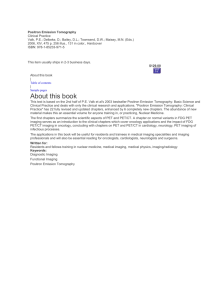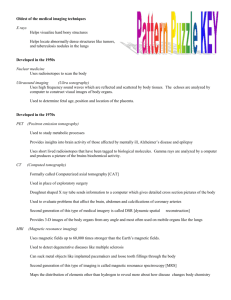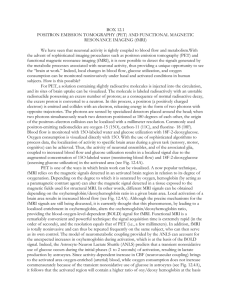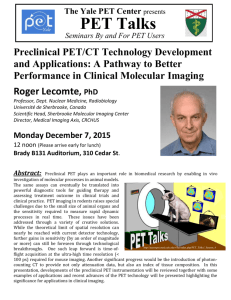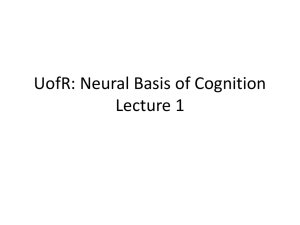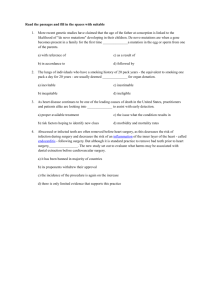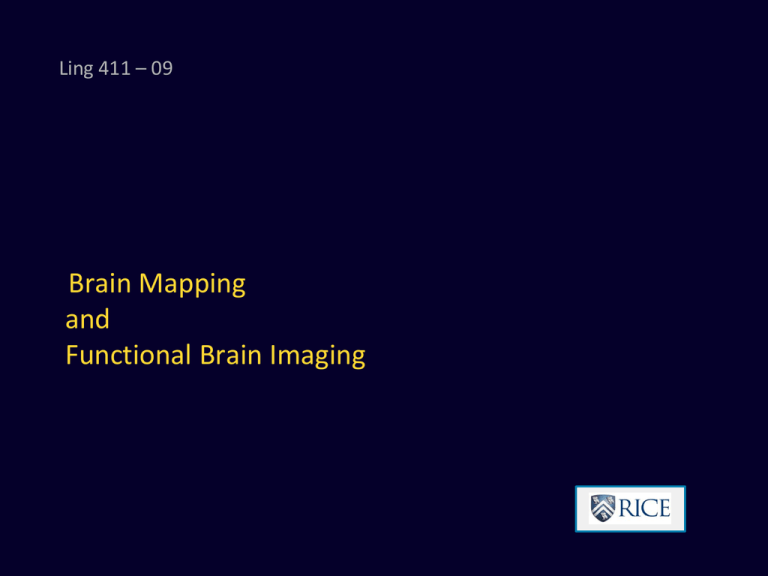
Ling 411 – 09
Brain Mapping
and
Functional Brain Imaging
Methods of localization
Lesion studies
• The traditional method
• For a long time, the only method
Selective anesthetization
Intra-operative mapping
• Started by Penfield and Roberts , 1960’s
Transcranial magnetic stimulation (TMS)
• Recently developed
• Very promising
Functional brain imaging
• Currently very popular
• Many techniques
Methods of localization
Lesion studies
• The traditional method
• For a long time, the only method
Selective anesthetization
Intra-operative mapping
• Started by Penfield and Roberts , 1960’s
Transcranial magnetic stimulation (TMS)
• Recently developed
• Very promising
Functional brain imaging
• Currently very popular
• Many techniques
Selective anesthetization
Temporarily anesthetize a portion of cortical tissue
• Injection of a drug in an artery
Usually sodium amytal
Rapid onset and short duration of effects
• Shuts down a portion of cortex till drug wears off
Usually injected in a carotid artery
• Left or right
• Shuts down a whole hemisphere
• The Wada test
In 10% of cases the findings disagree with those from fMRI
Methods of localization
Lesion studies
• The traditional method
• For a long time, the only method
Selective anesthetization
Intra-operative mapping
• Started by Penfield and Roberts , 1960’s
Transcranial magnetic stimulation (TMS)
• Recently developed
• Very promising
Functional brain imaging
• Currently very popular
• Many techniques
Electrical stimulation mapping
(A type of intra-operative mapping)
Early work by Penfield and Roberts
• Montreal
More recently, George Ojemann –
neurosurgeon, U. of Washington
• Book: Conversations with Neil’s
brain (with W. Calvin, 1994)
• Neil, a patient, suffers from epilepsy
Currently, in Texas Medical Center
• Nitin Tandon, UT
Intra-operative brain mapping
Performed on exposed neural tissue
• After craniotomy
• Used only in pathological conditions
E.g., epilepsy
Methods in use
• Electrical stimulation mapping
• Electrocorticograms
• Microelectrode recordings
George Ojemann and Neil’s Brain
(electrical stimulation mapping)
George Ojemann – neurosurgeon, U. of Washington
• Book: Conversations with Neil’s brain (with W.
Calvin, 1994)
• Neil, a patient, suffers from epilepsy
Intraoperative probing of part of Neil’s brain
• In the area suspected of causing seizures
• Probing to spare vital linguistic functions
• Additional probing for research
Probing Neil’s brain (Ojemann)
Aim: to localize functions
Area activated – “size of pencil eraser”
• I.e., about 1 sq cm
• Number of neurons under 1 sq cm
of cortical surface: 14,000,000
Test for “naming sites”
• Problem
“Naming sites” found in Neil’s brain
Probing Neil’s brain – “Naming sites”
Problems with “naming sites”
• Naming is a complex function
Therefore, not localizable
• Ojemann doesn’t distinguish different kinds of
objects
Additional problem in interpreting results:
• Input for testing is only pictures – visual stimuli
• Same problem comes up with results of many
imaging studies
“Naming sites” identified in the experiment
In Broca’s area
2. In Wernicke’s area
3. In supramarginal gyrus
• N.B.: Angular gyrus not considered
• Was not under the section of skull removed
• Probably also involved
1.
“Naming sites” – English and Spanish
Methods of localization
Lesion studies
• The traditional method
• For a long time, the only method
Selective anesthetization
Intra-operative mapping
• Started by Penfield and Roberts , 1960’s
Transcranial magnetic stimulation (TMS)
• Recently developed
• Very promising
Functional brain imaging
• Currently very popular
• Many techniques
Transcranial Magnetic Stimulation - TMS
Magnetic stimulation disrupts electrical activity
TMS disrupts activity only while it is being applied
• Recovery is immediate
Can induce temporary dysfunction of specific
areas – e.g. Broca’s area
Usefulness depends greatly on areal precision, a
function of expense
Methods of localization
Lesion studies
• The traditional method
• For a long time, the only method
Selective anesthetization
Intra-operative mapping
• Started by Penfield and Roberts , 1960’s
Transcranial magnetic stimulation (TMS)
• Recently developed
• Very promising
Functional brain imaging
• Currently very popular
• Many techniques
Brain imaging and functional brain imaging
Brain imaging
• Gets static image of brain structure
• Used for example in locating lesion areas
• E.g. MRI
• Exciting new development: DTI
Functional brain imaging
• Images of brain performing more or less specific
function
E.g., linguistic, motor, sensory, attention
That is the ideal, never actually realized
• E.g. fMRI
Functional Brain Imaging Techniques
Electroencephalography (EEG)
Positron Emission Tomography (PET)
Functional Magnetic Resonance Imaging (fMRI)
Magnetoencephalography (MEG)
• Magnetic source imaging (MSI)
Combines MEG with MRI
Spatial and Temporal Resolution
Spatial resolution
• How accurately is location determined?
• Recall: 14,000,000 neurons under 1 sq cm of
cortical surface
• Worst: EEG
• Best: MEG
Temporal resolution
• Accuracy in determining timing of activity
• Key neural events can occur within 5 ms
• Terrible: PET
• Pretty bad: fMRI
• Excellent: MEG and EEG
Electroencephalography (EEG)
An old technique, from the days before
mapping techniques were developed
• Was used for recording brain wave
activity, rather than for imaging
Any neuronal activity in the brain generates
electric current flow
Current flows through the cranium and scalp
The changes in electric potential are
detected by electrodes placed on the scalp
EEG Mapping
Nowadays multiple electrodes can be placed all over
the scalp, allowing the recording of the electric
activity from many different sites simultaneously
Allows the construction of topographic maps of the
momentary electric activity on the scalp
• i.e., excellent temporal resolution
Also permits study of the time series of these maps
with millisecond resolution
• But very poor spatial resolution
Multiple electrodes for mapping
http://brainmapping.unige.ch/researchtopics.php
ERP Mapping
ERP – event related potentials
Traditional analysis: ERP waveforms at certain electrode
positions
ERP mapping attempts to determine points in time when
map configurations change and/or when they differ
between experimental conditions
Relies on the fact that, whenever the spatial configuration
of the electric field on the scalp differs, different neuronal
populations are active in the brain, reflecting an alteration
of the functional state of the brain
Christoph M. Michel, Margitta Seeck and Theodor Landis,
Spatiotemporal Dynamics of Human Cognition
News Physiol. Sci 1999 Oct, 14:206-214
EEG-MRI Coregistration
Separate MRI images are taken
Reference points are used to get same positioning
• Impossible to get them accurate
But can get within a few mm
EEG-MRI Co-registration
•Spinelli L, Gonzalez Andino S, Lantz G, Seeck M, Michel CM.
Electromagnetic inverse solutions in anatomically constrained
spherical head models. Brain Topography 2000; 13: 115-126.
Some Properties of EEG-ERP Mapping
Spatial resolution: Very approximate
• The volume currents picked up by the EEG electrodes
are distorted as they pass through cranium and scalp
[see next slides]
• Hence, imperfect correspondence between surface
distribution and primary activation
• 2nd problem: inverse dipole modeling
With multiple dipoles, impossible to get a unique
solution
Temporal resolution: Excellent
Detecting electrical activity
Activation of neural fibers is electrical activity
Most fibers are too short to produce detectable
signal even when active
• Relatively longer fibers:
Apical dendrites of pyramidal neurons
Cortico-cortical axons
Dipoles
The activity of a single fiber is too weak to be detected
• Therefore we need multiple parallel fibers acting in
concert
Sets of neighboring apical dendrites firing
synchrounously
Such a set, when active, constitutes a dipole
Source and volume currents
Dipole
Secondary
currents
shown in
white
Papanicolaou 1999: 32
Volume Currents
Volume currents (read by an EEG) become distorted
as they follow lines of least electrical resistance
Flow through layers of tissue offering different
degrees of resistance (e.g., white matter, gray matter,
meninges, cerebrospinal fluid)
Become further distorted by the skull, which provides
the most resistance where it is thicker
Positron emission tomography (PET)
Tomography: Pictures (graph) of slices (tomo)
Positron emission:
• The pictures of brain activity result from emission of
positrons
• Positron
Subatomic particle with very short half life
Like an electron but with opposite charge
• As soon as an emitted positron meets an electron,
they annihilate each other and a photon is produced
• The photon is detected by the PET machine
Axial sections:
commonly used in brain imaging
• “From the
top/bottom”
• Accomplished by
use of
computerized
tomography
http://www.indiana.edu/~m555/axial/axial.html
PET Machine
http://www.radiologyinfo.org/content/petomography.htm
In a PET Machine
http://en.wikipedia.org/wiki/Positron_Emission_Tomography
Positron Emission Tomography (PET)
Measures the distribution of particular organic molecules
and compounds (e.g., water, glucose, neurotransmitters)
in the brain
The organic molecules and compounds are not detectable
because they do not emit electromagnetic signals
Positron-emitting isotopes of these organic molecules and
compounds are introduced into the blood intravenously
• It is necessary to have a cyclotron adjacent to the PET
facility to produce the radioactive isotopes
After a short time period, the isotopes are dispersed
throughout the brain
Positron Emission Tomography (PET)
These isotopes (in the blood) flow to the areas of the
brain with the highest metabolic needs
These areas are assumed to be the most active at the
given point in time
The positrons from the isotopes collide with electrons
These collisions produce photons, which can be
detected at the surface of the head
The greater the activation of an area, the more
positrons originate from that area
Positron Emission Tomography (PET)
Tomography is accomplished by computer
using sophisticated algorithms
The final PET images show areas of different
hues, each hue representing a different degree
of activation of the underlying brain structures
The final PET images are superimposed on a
structural image of the brain (MRI or CT scan)
Some PET Images
PET images courtesy of UCLA Department of Molecular and Medical Pharmacology
© 1995-2005, Healthwise, Incorporated, P.O. Box 1989, Boise, ID 83701. All Rights Reserved.
More PET
Images
http://encarta.msn.com/media_461519549_761555359_-1_1/Positron_Emission_Tomography.html
Some properties of PET
Spatial resolution: 5-10 mm
How good is that?
• Under one sq mm of cortical surface
130,000 neurons
1400 minicolumns (at est. avg. 93 neurons/col)
Temporal resolution: “…on the order of minutes…” (A.
Papanicolaou, Fundamentals of Functional Brain Imaging
(1998), p. 14)
PET study of object categories
Hanna Damasio, Thomas Grabowski, Daniel Tranel,
Richard Hichwa, Antonio Damasio, A neural basis for
lexical retrieval. Nature 380, 11 April 1996, 499-505
Different categories of concrete objects found to be
represented in different extrasylvian areas of left
hemisphere. Both normal subjects and those with
brain damage were tested.
Categories tested
Animals
Tools
Unique persons
E.g., J.F.K.
Subjects, method, and findings
127 subjects with focal brain lesions
• Category-related defects correlate with different
neural sites
9 normal subjects, tested with PET
• Differential activation of left temporal sites
comparable to those of the lesion study
Method: visual naming experiment
• Three categories: tools, animals, unique persons
Patients with defects in
more than one catetory
If two categories had defects, they were
• Animals and tools
or
• Animals and unique persons
If both tools and persons affected, then
animals were also
Q: What do these findings suggest?
Deficits vis-à-vis areas of damage
Abnormal access for names of unique persons
correlated with damage in left temporal pole
Abnormal access for names of animals correlated
with damage in left infero-temporal area
Abnormal access for names of tools correlated
with damage in posterolateral inferotemporal
and temporo-occipito-parietal junction area
Similar results from PET
experiment on normal subjects
Increased rCBF (regional cerebral blood flow) in
left temporal pole for naming unique persons
Some increase of rCBF also in right TP for
naming unique persons
Animals and tools activated left posterior
inferotemporal areas, more posterior for tools
Functional Magnetic Resonance Imaging (fMRI)
Measures the amount of oxygenated blood supplied
to different areas of the brain
• Common abbreviation: rCBF (regional cerebral blood flow)
When a group of neurons increases its signaling rate,
its metabolic rate increases
When the metabolic rate increases, the amount of
hemoglobin in the blood decreases
• Since brain metabolism requires oxygen
• Hemoglobin is the protein that delivers oxygen to
body tissues
• (Also collects CO2)
Functional Magnetic Resonance Imaging (fMRI)
The decrease in hemoglobin becomes apparent
approximately 2 seconds after the increase in
the neurons’ signaling rate
Then, oxygenated blood flows into the depleted
area, resulting in excessive amounts of
hemoglobin in the area
• This flood of oxygenated blood to the depleted
area occurs 5 to 8 seconds after the low level of
hemoglobin is detected
Functional Magnetic Resonance Imaging (fMRI)
The fMRI results are superimposed on a structural
MRI
MRI Machine
http://www.radiologyinfo.org/photocat/photos.cfm?Image=philips5.jpg&&subcategory=Brain
Another MRI Machine
http://www.radiologyinfo.org/photocat/photos.cfm?Image=hitachi.jpg&&subcategory=Brain
fMRI properties
Temporal resolution: not very good
Image reflects the increase in oxygenated blood that
occurs 5 to 8 seconds after the neurons fire
Records all activation that occurs within the recording
interval; does not separate early versus late activation
For example, there is no way to separate activation of,
for example, primary auditory cortex and higher-level
association cortices during a process of speech
comprehension
fMRI: Example
http://www.fmrib.ox.ac.uk/fmri_intro/fusion.gif
Another example
Areas of the brain
used in working
memory
www.firstscience.com/ SITE/ARTICLES/love.asp
Properties of fMRI
Spatial resolution: good
However, it is unclear whether the imaged
area is precisely the area involved in the
activity
• The flow of oxygenated blood into the
depleted area may also flow into
neighboring vessels in areas where neural
firing did not occur (next slides)
Active area
Area that “lights up” in fMRI
(hypothetical example)
Active area
REVIEW
Functional Brain Imaging Techniques
Electroencephalography (EEG)
Positron Emission Tomography (PET)
Functional Magnetic Resonance Imaging (fMRI)
Magnetoencephalography (MEG)
• Magnetic source imaging (MSI)
Combines MEG with MRI
end

